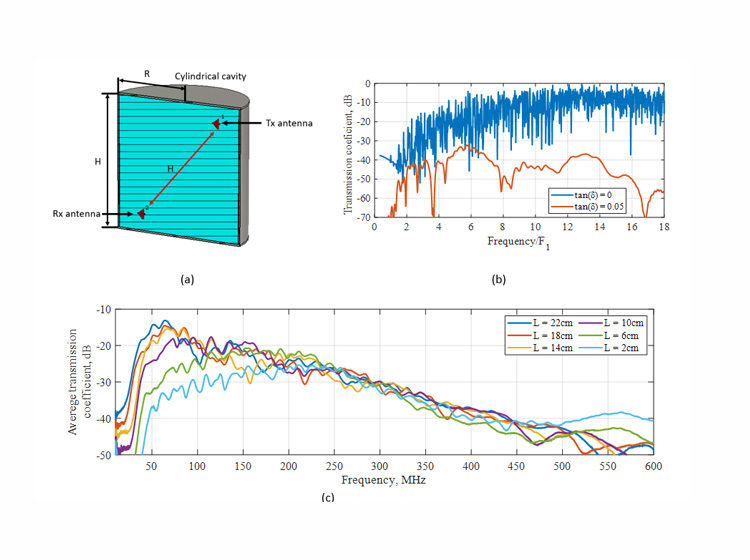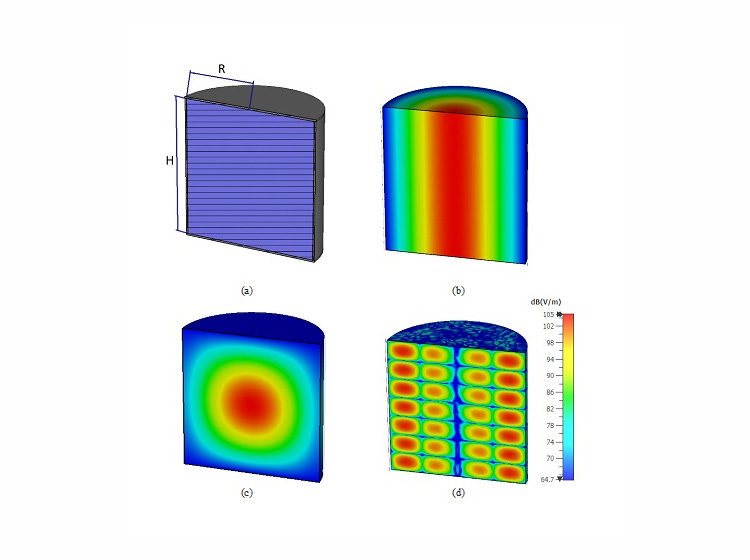Introduction
Wireless power transfer has gained significant attention in recent years. It was primarily driven by consumer demand, such as wireless charging of mobile devices (phones, tablets) being prime examples. However, it is important to remember that the idea of wireless power transfer is old and dates to the 19th century. To be precise, magnetic resonance as a means for Wireless Power Transfer (WPT) was first demonstrated by Hertz in 1887 [1], which was followed by experimental work by Nikola Tesla spanning the 1890s and up to 1920s, [2,3,4]. A major milestone in the field of wireless power transmission came in 1963, when William C. Brown demonstrated a wirelessly powered helicopter. Even though the work on wireless power continues to this day, it is important to understand the types of wireless power transfer, their efficiencies and ultimately limitations.
In general, wireless power transfer comes in two basic flavours: near field and far field. The distinction is made with regards to the relative positions of the transmitting and receiving circuits.
Near field wireless power transfer, in general, occurs when the transmitting and receiving circuits are located up to one wavelength apart from each other, however, this definition is rather broad and of limited use in wireless charging. Here, it is important to note that strictly speaking, the near field region consists of 2 sub-regions: reactive near field and radiative near field. The reactive near field, characterized by rapid variations of the electric and magnetic fields, occurs up to the distance of (λ0 /2π) from the transmitting circuit and the radiative near field region occurs between (λ0 /2π) and λ0. The reactive near field region is of high importance to modern wireless charging for 2 main reasons:
- The efficiency of wireless charging in the reactive near field region is a strong function of distance. The Electro-Magnetic (EM) fields in this region decay as a function of ~r3, inferring that maximum power transfer occurs when the transmitting and receiving devices are in a close proximity of each other.
- The reactive near field is non-radiative, inferring that wireless power transfer in this case does not require an antenna of any kind. Instead, in most near field wireless power transfer technologies inductive coupling is used, which consists of inductive coils at the transmitting and receiving ends, Fig. 1. Being non radiative, this wireless power transmission technology infers that health risks due to magnetic field exposure are minimized. For better efficiency, a capacitor can be added in series with the inductor coils both at the transmitting and receiving ends, creating a resonant circuit. The circuit obtained in this way is best operated at the resonant frequency, given by: fr=1/(2π√(LiC)’) , (i = 1,2) as at this frequency point the reactive losses of the power transfer circuit are zero and the only losses in the primary and secondary coils come from the parasitic resistances in the circuit.
It is worth mentioning that reactive near field wireless power transmission can also be performed using electric fields, in which case capacitive plates are used – one at the transmitting end and the second at the receiving end, Fig. 2. This case can be considered the conjugate of inductive coupling as energy is transmitted by electric fields, rather than magnetic fields. By bringing the capacitive plates in proximity to each other an Alternating Current (AC) will begin to flow, thereby catering for power transmission. The closer the plates are, the more efficient power transfer is. In addition, increasing the frequency of operation reduces the reactance produced by the capacitive plates, inferring greater efficiency. Similar to the case of inductive near field wireless power transmission, near field capacitive charging benefits from the creation of a resonant circuit – in this case, however, instead of a capacitor, an inductor is added in series. However, this type of wireless power transfer is very rarely used, primarily since high voltages and, hence high electric fields, are needed for efficient power transmission, which can become a health hazard. This is since electric fields interact to a much greater degree with the human body compared to magnetic fields.

Fig. 1 Inductive wireless power transfer

Fig. 2 Capacitive wireless power transfer
Near field wireless power transfer, particularly in the inductive coupling, has found various commercial uses – examples span from electric toothbrushes, shavers and wireless charging pads for mobile phones, tablets. At present there are two main “camps” promoting their own versions of near field wireless charging, Wireless Power Consortium, [5], promoting the Qi standard [6] and the AirfuelAlliance [7], promoting AirFuel Resonant [8]. It is worth mentioning the the Qi standard is universal, open standard and operates, depending on the power level, at frequencies from 5 kHz to 300 kHz whereas AirFuel Resonant operating frequencies are expected to be 6.78 MHz [9]. The expected main advantage of AirFuel Resonant lies with the fact that it can charge several devices at the same time.
Regardless of the standards used, the efficiency of near-field wireless powering will always be lower than its wired competition. Efficiency in this case strongly depends on the separation between the coils, frequency of operation, alignment of transmitters and receivers and the thicknesses of coils and complexity of drive electronics. However, in the best-case scenarios, efficiencies up 80% appear to be achievable [10].
Far field wireless power transfer, in general, relies on the use of directive antenna, to “beam” the power to a desired user, where it will be subsequently, through a rectifier circuit, such as rectennas, converted to dc power. Their practical use has been demonstrated on numerous occasions, such as the experiment in Reunion [11], which used a 33 dBi gain antenna to wirelessly transmit power to 700 m, with an overall efficiency of over 57%. The system operates at a frequency of 2.45 GHz.
The efficiency of far field wireless power transfer technique is given by the following equation:

infers that the total efficiency of the far field wireless power transfer depends on the antenna gains of the transmitting and receiving circuits, given Gt by and Gr , respectively and, the term given by (λ/4πd)2 , which corresponds to the efficiency when the transmit and receive radiators are fully isotropic. (1) and (2) infer that total efficiency decays 2 times faster as wavelength (λ) is reduced, and separation (d) increased compared to the increase in the gains of transmitting (Gt) and receiving (Gr) antennas. Viewed in this way, efficiency of far-field wireless power transfer solutions will always decrease as the separation between transmitting and receiving antennas increase regardless of the antenna gains. The main question, however, is what is an acceptable efficiency that consumers will tolerate? The answer to this lies with consumer needs. As an example, it is noteworthy to mention that far-field wireless transfer technologies have already found their way to the market – example includes Energous [12], operating at 900 MHz and using 24 antennas, who claim that their technology operates both in the near field and far field. Another example is Ossia Cota [13,14], however, it appears that their technology, despite appearing to be so, is not based on far-field wireless power transfer – rather it uses a complex near field wireless approach utilizing hundreds of antennas operating at frequencies of 2.4 GHz and 5.8 GHz. However, no information of achievable efficiencies has been reported.
Conclusion
Wireless power transfer technologies have gained considerable interest both from academia and industry in recent years. Whie it is obvious that no wireless transfer technology can match the efficiency of its wired counterparts, it is still not clear what an ultimate wireless power transfer technology will look like – will it be near field? Far-field? A combination of both? Or something different? At this point it is difficult to predict it with certainty, making this a very interesting time both for research and the wireless power transfer industry.
References:
[1] H. Hertz, Electric Waves: Being Researches on the Propagation of Electric Action With Finite Velocity Through Space. New York, NY, USA: Dover, 1962.
[2] https://patents.google.com/patent/US649621A/en.
[3] https://patents.google.com/patent/US645576A/en .
[4] R. Bhutkar and S. Sapre, “Wireless Energy Transfer using Magnetic Resonance”, in 2009 Second International Conference on Computer and Electrical Engineering, https://doi.org/10.1109/ICCEE.2009.194, Dubai, United Arab Emirates.
[5] https://en.wikipedia.org/wiki/Wireless_Power_Consortium.
[6] https://en.wikipedia.org/wiki/Qi_(standard).
[7] https://airfuel.org/.
[8] https://airfuel.org/airfuel-resonant/.
[9]https://airfuel.org/frequency-.choice/#:~:text=While%20regulatory%20design%20challenges%20may,such%20as%20wireless%20power%20systems).
[10] N. Ha-Van, C.R. Simovski, F.S. Cuesta, P. Jayathurathnage, and S.A. Tretyakov, Phys. Rev. Applied 20, 014044 – Published 20 July 2023.
[11] https://web.archive.org/web/20051023080942/http://www2.univ-reunion.fr/~lcks/Old_Version/PubIAF97.htm.
[12] https://energous.com/.
[13] https://www.ossia.com/cota.
[14] https://f.hubspotusercontent30.net/hubfs/2870932/Content%20Offers/Whitepapers/Cota%20vs%20Other%20Wireless%20Power%20Technologies.pdf.
[15] https://www.electronicdesign.com/technologies/power/whitepaper/21178200/electronic-design-rethinking-wireless-power-a-closer-look-at-ossias-technology.



Leave a Reply